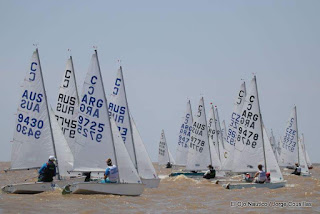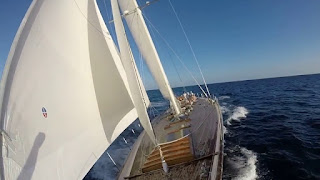Protecting your start
Protecting your start
For prolonged success in sailboat racing it is imperative
to consistently get away well at the start. It will greatly increase the
likelihood of a good race and whilst a bad beginning is not the end of your
day, you just made it a whole lot harder!
What is a good
start?
The benefits of a good start are obvious, clear wind,
proactive tactics and most importantly you are already ahead of most of your
opposition. The single best way to achieve a good start at speed and on the
line is to have room under your bow. This gives you a nice space to build speed
and to dip down and keep below the line if you are close. This can be difficult
to achieve as the starting process in sailing is unique. Coaches from other
sports are often quite amazed that in sailing there is no set procedure except
for the countdown. We sailors literally have a situation where the race
committee say you are starting here in 5 minutes, sort yourselves out!
So we set ourselves up with a nice gap to leeward but
other boats have the right to jump in there and take our spot away from us. So
the big question is how we protect ourselves from the pest who wants to come in
below us.
Requirements
Whenever boats are in close proximity it is advisable to
have a good working knowledge of the rules. In terms of skill sets being able
to sail and manoeuvre your boat at low speeds is very handy. The ability to be
able to keep control down-speed and move your boat around is a real boon, on
smaller lighter yachts it is quite easy to achieve and much more difficult on
larger displacement vessels. They often have more crew and the ensuing
communication issues through distance between crew and greater numbers of them
can make it harder. Plus the boats are usually less responsive.
It is one of the very few times where the helm has to
look around and be aware, in most cases the danger of someone taking your
leeward gap will come from astern. During the race the main focus for the helm
is eyes ahead and occasionally aside (crews are usually very good at constantly
reminding the helm of this). So keep an eye out for potential problems, early
detection of another boat is crucial to defending your spot. So let’s look at a
few scenarios.
Boat coming from
astern
This is the most likely scenario, most starts have all
the yachts lining up on starboard tack. A boat coming in from behind that nips
into the spot below you. Important to know that under the rules, the moment they
have an overlap they can luff you up as high as head to wind. This is because
no proper course exists before the starting gun. Once the gun has gone and a
course is established they can only luff you to a close hauled course and must
initially keep clear of you as they become a boat clear astern coming in from
that angle. The key is to recognise their intentions early so you react before
they get an overlap. As soon as you see them eyeing your precious gap, bear
away across their bow forcing them to go above you, then come back up and
reclaim your spot.
Sometimes if the other boat is coming in very hot or fast
and there is some time to burn until start, then it is ok to let them go. They
will slide through very quickly and have to bear away and head down the line to
keep from being OCS and once gone they are someone else’s problem!
Figure 1Yellow
bears away forcing blue above to protect their space.
The Port Tacker
The other one is the port tacker who comes in and tacks
under you and claims your spot. This boat is a bit harder to deal with. Once
again early recognition is the key. The best way to deal with them is often to
bear away and steer at him as starboard tack boat. This gives them two options,
hopefully they will take your stern and continue or tack above you.
Alternatively he may tack below you, as soon you see this shoot back up to
regain as much of your “gap” as you can. Point to note whilst you have right of
way, under the rules you also have an obligation to avoid a collision. So do it
as early as possible to give them room and time to respond to your starboard
tack advantage.
Figure 2-
Yellow bears away forcing Blue to tack early
The other way to deal with
this port tack approach is to do a quick double tack. This can only occur if
you have some room above you. As the other boat tacks into your space, you tack
away. Once tacked, bear away to quickly rebuild speed and then tack back. This
will seem a bit fraught with danger but can be managed with a bit of practise.
You can do this manoeuvre in surprising little space once you become
comfortable with it!
Figure 3Blue
tacks to leeward taking yellows spot a quick double tack allows yellow to reset
up
Use the space.
The tactics above show how to defend and protect space on
the start line. You can use the rules to help your situation. But always
remember you have worked hard to keep that nice gap to leeward, so make sure
you use it! I have seen and been on a lot of boats that sit still and wait for
the gun to go and then try to accelerate only for boats that have jumped
earlier to roll over them. My other favourite is the skipper who is so excited
about luffing the boat above that he lets everyone else get away around him and
his opponent. In the final stages of the
countdown use that space to accelerate into and jump away. The ability to get
this jump is invaluable in all sailing. Very important in One Design sailing
and still very relevant in mixed keelboat handicap racing. The longer you can
sail in free air helps a lot in your race against the clock.
So consider working to protect your space and improve
your boat handling, you don’t have to be too aggressive or gung ho. Just use
your rules and take into account the manoeuvring and limitations of the other
yachts.
Next issue we may look at when the best laid plans go
astray and we inevitably have a bad start, how do we recover?
Good Sailing







Comments
Post a Comment